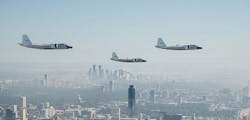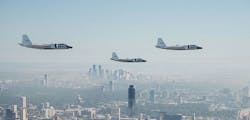Southern Research wins $10M NASA contract to support Airborne Imaging and Recording System
BIRMINGHAM, Ala., 9 Aug. 2016. Southern Research, a non-profit organization in Birmingham, Alabama, won a $9.95 million, five-year, sole-source contract renewal from NASA to continue supporting the Airborne Imaging and Recording System (AIRS) on WB-57 research aircraft.
"After the success of our initial AIRS project, NASA began to develop new applications for the technology, and we have been pleased to play an expanded role supporting NASA's high-altitude research team ever since," says Johanna Lewis, director, Program Management Office, Southern Research Engineering division. “We consider it an honor to be able to support NASA, in any mission."
NASA's three WB-57s flying over Houston. This footage was captured by the AIRS/DyNAMITE system technology that was developed in Southern Research Engineering labs.
Southern Research engineers started working on AIRS in 2003 to develop a high-definition video imaging system capable of monitoring the upcoming NASA STS-114 Return to Flight shuttle launch following the Columbia accident. The technology was developed in a Southern Research lab and designed to affix to the nose cap of a WB-57 aircraft. In this capacity, AIRS proved capable of providing full-motion, high-definition (HD) video of rocket launches ascending into space at distances far exceeding 25 miles.
The WB-57 is a unique plane originally designed as a B-57 bomber. NASA first began to retrofit the planes in the 1960s to be used for science and research purposes — the "W" added to the name stands for weather. Today, only three WB-57s are in service; they are frequently flown at heights exceeding 60,000 feet and at speeds reaching 410 knots (max mach .78).
Actual footage taken from the AIRS system on a WB-57 of SpaceX Falcon 9 CRS-4.
The AIRS-equipped WB-57s were first used to provide full-motion video (FMV) of the NASA STS-114 launch in 2005. They have since monitored numerous launches and re-entries for government agencies such as NASA and the Department of Defense (DoD), as well as commercial launches such as SpaceX. Additionally, AIRS technology has been used to conduct atmospheric research missions, high-altitude mapping, remote sensing operations, and more. The WB-57 fleet is also used by NASA to conduct high-altitude training for astronauts.
"When it comes to working on and around the issues of space flight, there is endless possibility but no room for error," explains Michael D. Johns, Ph.D., vice president of the Engineering Division at Southern Research. "In order to be successful throughout the years, our team has embraced each new challenge with a level of dedication and professional intrigue that has allowed us to advance the AIRS technology and add value as partners in the expansion of the WB-57 program. The fact that NASA has honored us with a second sole source contract to continue this work is a signal that we have yet to cross the final frontier."
Southern Research is a not-for-profit 501(c)(3) organization with more than 400 scientists and engineers working across four divisions: drug discovery, drug development, engineering, and energy and environment. The company works on behalf of the National Cancer Institute, National Institutes of Health, the U.S. Department of Defense, the U.S. Department of Energy, NASA, major aerospace firms, utility companies, and other private and government organizations. SR, founded in 1941, is headquartered in Birmingham with additional laboratories and offices in Wilsonville and Huntsville, Alabama; Frederick, Maryland; Durham, North Carolina; Cartersville, Georgia; and Houston.
Search the Aerospace & Defense Buyer's Guide
You might also like:
Subscribe today to receive all the latest aerospace technology and engineering news, delivered directly to your e-mail inbox twice a week (Tuesdays and Thursdays). Sign upfor your free subscription to the Intelligent Inbox e-newsletter at http://www.intelligent-aerospace.com/subscribe.html.
Connect with Intelligent Aerospace on social media: Twitter (@IntelligentAero), LinkedIn,Google+, and Instagram.
Intelligent Aerospace
Global Aerospace Technology NetworkIntelligent Aerospace, the global aerospace technology network, reports on the latest tools, technologies, and trends of vital importance to aerospace professionals involved in air traffic control, airport operations, satellites and space, and commercial and military avionics on fixed-wing, rotor-wing, and unmanned aircraft throughout the world.


